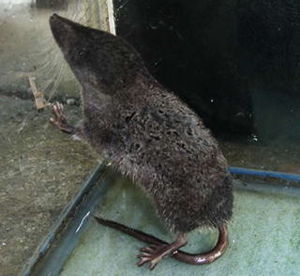Beaver shrews
| Beaver shrews | ||||||||||||
|---|---|---|---|---|---|---|---|---|---|---|---|---|

Japanese water shrew ( Chimarrogale platycephala ) |
||||||||||||
| Systematics | ||||||||||||
|
||||||||||||
| Scientific name | ||||||||||||
| Chimarrogale | ||||||||||||
| Anderson , 1877 |
The beaver shrews or Asiatic water shrews ( Chimarrogale ) form a genus of shrews with six species that live in East and Southeast Asia .
features
Beaver shrews are physically similar to European water shrews , but they are significantly larger. Like these, they show some adaptations to an aquatic way of life: the feet are equipped with a bristle border that, like a webbing, enables rapid progress in the water. The eyes are small, as are the ears, which can be closed. The fur is dense and water-repellent, it is grayish to black in color on the upper side, often with light speckles, the underside is lighter. These animals reach a head body length of 8 to 14 centimeters, a tail length of 6 to 12 centimeters and a weight of 27 to 43 grams.
Distribution and way of life
The distribution area of the beaver shrews extends from the Kashmir region and Japan via China and the Malay Peninsula to Sumatra and Borneo . Their habitat are rivers in mountain regions up to 3300 meters above sea level.
They swim and dive well, and feed on insects and their larvae, crustaceans and fish .
Several species are threatened due to water pollution and the destruction of their habitat. Two species are listed as critically endangered by the IUCN .
The species
- The Malay water shrew ( Chimarrogale hantu ) lives in the south of the Malay Peninsula and is considered to be critically endangered.
- The Himalayan water shrew ( Chimarrogale himalayica ) is widespread from Kashmir through southern China and Taiwan to Thailand .
- The Borneo water shrew ( Chimarrogale phaeura ) is endemic to Borneo and is considered endangered.
- The Japanese water shrew ( Chimarrogale platycephala ) lives in Japan .
- The Chinese water shrew ( Chimarrogale styani ) is native to southern China and northern Myanmar .
- The Sumatran water shrew ( Chimarrogale sumatrana ) is endemic to Sumatra . The species only inhabits a small area in the west of the island and is listed as critically endangered.
literature
- Ronald M. Nowak: Walker's Mammals of the World. 2 volumes. 6th edition. The Johns Hopkins University Press, Baltimore MD et al. 1999, ISBN 0-8018-5789-9 .
- Don E. Wilson , DeeAnn M. Reeder (Eds.): Mammal Species of the World . A taxonomic and geographic Reference. 2 volumes. 3. Edition. The Johns Hopkins University Press, Baltimore MD 2005, ISBN 0-8018-8221-4 .
Web links
- Endangerment level of the individual species in the IUCN Red List of Threatened Species .
- Illustration of the Himalayan water shrew